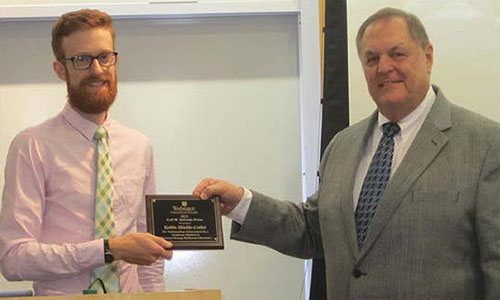Robin Shields-Cutler Awarded the 2015 Ceil M. DeGutis Prize
 On June 9, 2015, Robin Shields-Cutler was awarded the 2015 Ceil M. DeGutis Prize in Chemical Biology/Medicinal Chemistry. Robin presented his research at the DeGutis Presentation on June 9th entitled: How the human urinary metabolome supercharges antimicrobial defenses. Robin graduated this Spring from the Molecular Microbiology and Microbial Pathogenesis graduate program. He has accepted a 1-year position as Assistant Professor of Biology at Grinnell College, in Grinnell, IA, that begins this fall. After that, he’ll complete his postdoctoral research.
On June 9, 2015, Robin Shields-Cutler was awarded the 2015 Ceil M. DeGutis Prize in Chemical Biology/Medicinal Chemistry. Robin presented his research at the DeGutis Presentation on June 9th entitled: How the human urinary metabolome supercharges antimicrobial defenses. Robin graduated this Spring from the Molecular Microbiology and Microbial Pathogenesis graduate program. He has accepted a 1-year position as Assistant Professor of Biology at Grinnell College, in Grinnell, IA, that begins this fall. After that, he’ll complete his postdoctoral research.
Robin was nominated by his Thesis Mentor, Dr. Jeff Henderson, for his work on protein-metabolite interactions which established the basis for a new pharmacologic approach to urinary tract infections that may be combined with other antivirulence approaches in this area.
Robin’s work has focused on a soluble innate immune protein called siderocalin (also known as lipocalin-2/Lcn2, neutrophil gelatinase-associated protein/NGAL, or 24p3) that is released from white blood cell granules or synthesized de novo in epithelial cells following pro-inflammatory stimuli. For the past decade, siderocalin (SCN) has been known to inhibit E.coli growth by binding ferric ion complexes of the siderophore enterobactin, a bacterial iron acquisition molecule. Robin identified discrepancies in the literature suggesting a different mode of action in human urine, an environment relevant to urinary tract infections (UTIs). He pursued this line of study and found that in urine, SCN instead inhibits E.coli growth by binding ferric ion complexes of distinctive urinary metabolites. He developed a biophysical screen capable of identifying these SCN-binding metabolites in human urine and has used mass spectrometry-based metabolomics approaches to determine their structures.
In this distinctive urinary context, Robin found that the E.coli siderophore enterobactin becomes critical for resisting SCN –the opposite of its previously understood role. He then showed that a previously known lead compound under development as an M. tuberculosis antivirulence agent potentiates SCN’s antibacterial activity by inhibiting enterobactin biosynthesis. This repurposed compound now serves as a distinctive lead for a new pharmacologic strategy to potentiate an innate antibacterial response.
Click on the following to view more photos or a slideshow of the photos taken at the event.
